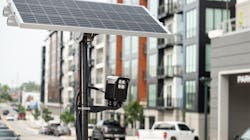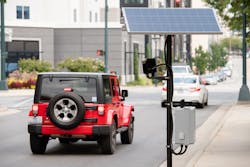How to Get the Benefits of License Plate Reader Technology on a Tight Budget
Click here for more information
Over the past two years, agencies and their officers have faced intense scrutiny, along with extreme COVID-19 circumstances that put their communities on edge. Departments are operating with fewer officers on tighter budgets. Long overtime hours and risky pandemic conditions compound officer challenges during this emotionally heightened era. With record-high officer attrition, a dwindling recruitment pool, and new restrictions on financial resources and policing tactics, how do agencies safely and effectively serve their communities? Many are looking to license plate recognition (LPR) technology.
LPR technology is a police force multiplier that can substantially alleviate some of the current strains on officers and agencies. LPR systems work behind the scenes to proactively find suspect vehicles in real time and assist investigations with the data it gathers. This technology, which first came into use in the late 1970s, has been significantly improved over the decades, thanks to advances in video analytics software. LPR now aids every mission and situation that involves a license plate—traffic management, finding missing persons, auto theft, BOLOs, and beyond.
Has your agency considered implementing a license plate reader (LPR) program but lacks the funds? Or maybe you'd like to expand your existing LPR program to assist additional missions or add systems to reinforce what you're already using them for, but tight budgets are holding you back.There's great news! One of the leading developers of highly advanced LPR technology for law enforcement recognized the need for an economical and more accessible means of deploying plate reader systems in cities and neighborhoods. Leonardo offers a low-cost, autonomous license plate reader system that's easy to install and economical to operate. It's called the ELSAG® Street Sentry, and it's a game-changer for jurisdictions that need to supplement police presence in their cities and towns and even in neighborhood areas.
Deploying just one ELSAG Street Sentry allows agencies to find suspect vehicles quickly and stop them in real time. But the affordability of Street Sentry also means police departments can create LPR safety nets in their communities. Agencies are concentrating deployments in vulnerable areas and placing systems at the entrances and exits to key geographical areas like major corridors coming into or going out of your city and high crime areas.
To learn more about the ELSAG Street Sentry, click here.
How does the ELSAG Street Sentry work?
The ELSAG Street Sentry reads plates 24/7 on city and neighborhood streets to identify suspicious vehicles and provide data to officers for real-time interdiction and investigations. It is solar-powered and reads license plates day and night, in any weather, including extreme temperatures. Each plate number is automatically and instantaneously compared to hot lists to identify suspect vehicles or to white lists to grant vehicles access to 'authorized only' areas. For each suspect vehicle identified, alarms broadcast in real time to a command center, patrolling vehicles, and mobile devices for immediate reaction.
Each license plate read captures a color and black & white photo of the license plate, the plate number, camera identifier, and date and time stamps. Leonardo also offers a robust data management software suite that stores the data and facilitates query and analysis. The ELSAG Enterprise Operations Center (ELSAG EOC) can reveal information extremely helpful to investigations and quickly resolve cases. ELSAG EOC filters the LPR data according to user-designated criteria such as plate number, time ranges, vehicle make, type and color, as well as other in-depth information. The results of such queries can lead to:
- Confirming a suspect vehicle at a scene
- Identification of eyewitnesses
- Discovery of travel patterns
- Documentation of vehicles traveling together
- And much more
The ELSAG EOC collects data from all Street Sentry cameras in a network or a single system. The LPR data can be stored according to agency protocol, and for complete transparency, includes an audit trail of all user activity.
What are the main benefits of the Street Sentry?
- It's an affordable, autonomous license plate reader system.
- It eliminates the need for electrical and communications infrastructure by using solar power and a cellular modem.
- Street Sentry seamlessly incorporates into existing ELSAG LPR networks or performs effectively on its own.
- LPR data collected can be stored in a data management center and analyzed to aid investigations.
In a nutshell, the solar-powered, pole-mounted, all-in-one Street Sentry is a low-cost system that can aid a myriad of public safety objectives, dramatically increasing officers' productivity by finding suspect vehicles quickly.
Which Agencies Should Use the ELSAG Street Sentry?
It's perfect for agencies of all sizes. Its solar-power design is especially attractive to agencies with green initiatives.
What sets Street Sentry apart?
"Street Sentry is a game-changer," says Jason Laquatra, general manager of Leonardo's U.S. subsidiary Selex ES Inc. "It makes the force-multiplying benefits of our LPR affordable, even for small agencies. Couple that with our industry-leading support, and it's never been a better time to start or grow your LPR program."
What's the next step if your department is ready to purchase?
Purchasing new equipment and technology can be challenging, especially for agencies with lean budgets. Leonardo understands that and they not only made the Street Sentry affordable, but they offer many financing options so agencies can choose the plan that works best for them. Consider purchasing the Street Sentry upfront, financing systems over multiple years, or an annual subscription might fit your budget better.
To learn more about Street Sentry click here or contact Leonardo for information about other LPR solutions.




